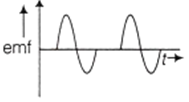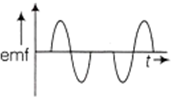 Multiple Choice Questions
Multiple Choice QuestionsA simple pendulum of length l1 has a time period of 2 s and another pendulum of length l2 has a time period of 1 s. Then, the time period of pendulum having length l1 − l2 will be
2 s
1.2 s
3 s
s
D.
s
Springs of spring constants K, 2K,4K, 8K...are connected in series.A mass m kg is attached to the lower end of the last spring and the system is allowed to vibrate. The time period of oscillations is (Given, m= 40 g and k =2.0 N-cm-1)
2.12 s
0.126 s
1.26 s
0.0126 s
A pendulum made of a uniform wire of cross-sectional area A has time period T. When an additional mass M is added to its bob, the time period changes to Tm . If the Young's modulus of the material is Y, then is equal to
Which of the following graphs represents resonance for low damping ?

graph (1)
graph (2)
graph (3)
None of these
A magnet is made to oscillate with a particular frequency, passing through a coil as shown in the figure. The time variation of the magnitude of emf generated across the coil during one cycle is





A particle executes simple harmonic motion between x = − A and x = + A. The time taken for it to go from O to A/ 2 is T1 and to go from A/2 to A is T2 . Then
T1 < T2
T1 > T2
T1 = T2
T1 = 2T2
A body executes simple harmonic motion. The potential energy (PE), kinetic energy (KE) and total energy (TE) are measured as a function of displacement y. Which of the following statements is true ?
TE is zero when x = 0
PE is maximum when x = 0
KE is maximum when x = O
KE is maximum when x is maximum
A particle starts SHM from the mean position. Its amplitude is a and total energy E. At one instant its kinetic energy is 3 · Its displacement at that instant is
